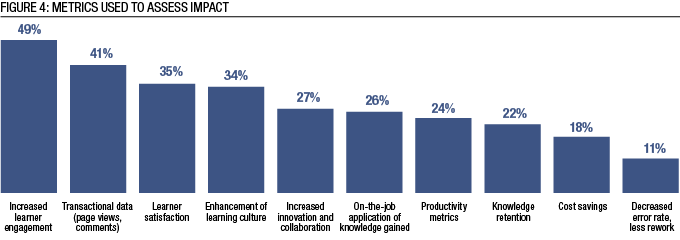Psychologist Albert Bandura’s social learning theory suggests that people learn from one another through observation, imitation and modeling. In a famous series of experiments to demonstrate his theory, Bandura studied children’s behavior after they watched a human adult model act aggressively toward a Bobo doll — a toy with a rounded bottom that returns to an upright position after it has been knocked down. The experiments showed that children who were exposed to the aggressive model were more likely to show aggressive behavior themselves.
It’s a compelling theory, and many organizations incorporate social learning into their learning and development function, especially with the growing array of technologies available today to facilitate such learning.
According to data from the Chief Learning Officer Business Intelligence Board, 75 percent of surveyed L&D professionals have adopted — fully or to some extent — social learning technologies into their learning strategy (Figure 1). Among the most adopted technologies are secure instant messaging, discussion forums, video channels, online shared work spaces and internal blogs.
 The Chief Learning Officer Business Intelligence Board is a group of 1,500 professionals in the L&D industry who have agreed to be surveyed by the Human Capital Media Research and Advisory Group, the research and advisory arm of Chief Learning Officer magazine.
The Chief Learning Officer Business Intelligence Board is a group of 1,500 professionals in the L&D industry who have agreed to be surveyed by the Human Capital Media Research and Advisory Group, the research and advisory arm of Chief Learning Officer magazine.
Interestingly, the top motivators cited for using social learning technologies are more abstract than tangible. More than 60 percent of respondents said creating and supporting a culture of learning in their organization was a driving factor (Figure 2). Forty-seven percent cited encouraging collaboration and 42 percent said increasing learner engagement was a motivator. Only 17 percent cited cutting costs related to other delivery methods, a more concrete outcome.

The intangible nature of these top motivators makes them harder to quantify. Among the challenges survey respondents noted when implementing social learning technologies were difficulty measuring the impact of those technologies on the business, buy-in from leadership and worries about employees “wasting time” (Figure 3). These challenges may help explain why 25 percent of respondents’ organizations do not incorporate any social learning technologies into their learning strategy.

However, perhaps a shift in business metric focus could provide more compelling evidence for gaining leadership buy-in for social learning. Currently, learning leaders are dedicating efforts toward measuring increased learner engagement and transactional data versus on-the-job application of knowledge gained through social learning, productivity metrics, knowledge retention and cost savings (Figure 4).

The ability of social learning technologies to provide on-demand access to real-time discussion, training, support and expertise, as well as foster on-the-job learning through communities of practice, make them a valuable asset and well worth the effort to gain buy-in on their behalf.
Figures’ source: Chief Learning Officer Business Intelligence Board, N=500. All percentages rounded.














